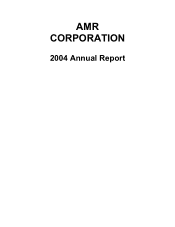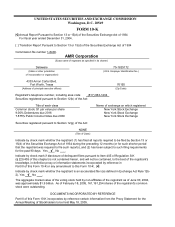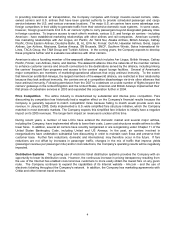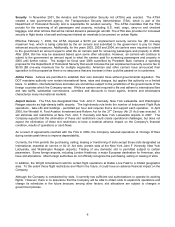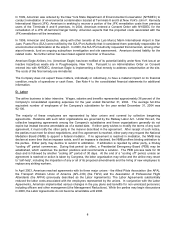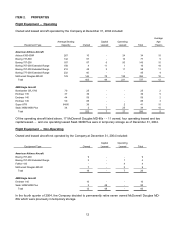American Airlines 2004 Annual Report Download - page 5
Download and view the complete annual report
Please find page 5 of the 2004 American Airlines annual report below. You can navigate through the pages in the report by either clicking on the pages listed below, or by using the keyword search tool below to find specific information within the annual report.2
The Company’s 2004 operating and financial results were also adversely affected by the significant increases in
the price of jet fuel. Fuel price increases during 2004 resulted in a year-over-year increase of 33.9 cents per
gallon. This price increase negatively impacted fuel expense by $1.1 billion during the year. Continuing high fuel
prices, additional increases in the price of fuel, and/or disruptions in the supply of fuel, would further adversely
affect the Company’s financial condition and its results of operations.
In response to the challenges faced by the Company, during the past four years the Company has implemented
several restructuring and other initiatives:
• Following the Terrorist Attacks, the Company reduced its operating schedule by approximately 20 percent and
reduced its workforce by approximately 20,000 jobs.
• In 2002, the Company announced a series of initiatives to reduce its annual costs by $2 billion. These
initiatives are being implemented through 2005, and involve: (i) scheduling efficiencies, (ii) fleet simplification,
(iii) streamlined customer interaction, (iv) distribution modifications, (v) in-flight product changes, (vi)
operational changes and (vii) headquarters/administration efficiencies. As a result of these initiatives, the
Company reduced an estimated 7,000 jobs by March 2003.
• In February 2003, American asked its employees for approximately $1.8 billion in annual savings through a
combination of changes in wages, benefits and work rules. In April 2003, American reached agreements with
its three unions (the Labor Agreements) and also implemented various changes in the pay plans and benefits
for non-unionized personnel, including officers and other management (the Management Reductions). The
Labor Agreements and Management Reductions resulted in $1.8 billion in annual savings including a
workforce reduction of approximately 9,300 jobs. In addition, the Company and American reached
concessionary agreements with certain vendors, lessors, lenders and suppliers (collectively, the Vendors, and
the agreements, the Vendor Agreements), resulting in approximately $200 million in annual cost savings.
Generally, under the terms of these Vendor Agreements, the Company or American received the benefit of
lower rates and charges for certain goods and services, and more favorable rent and financing terms with
respect to certain of its aircraft.
• Subsequent to the April 2003 Labor Agreements the Company announced the Turnaround Plan. The
Turnaround Plan is the Company’s strategic framework for returning to sustained profitability and emphasizes:
(i) lower costs, (ii) an increased focus on what customers’ truly value and are prepared to pay for, (iii)
increased union and employee involvement in the operation of the Company and (iv) the need for a more
sound balance sheet/financial structure.
• In the latter part of 2003 and throughout 2004, the Company continued to work – under the basic tenets of the
Turnaround Plan – with its unions and employees to identify and implement additional initiatives designed to
increase efficiencies and revenues and reduce costs. These initiatives included: (i) the return of under-used
gate space and the consolidation of the Company’s terminal space, (ii) the de-peaking of its hub at Miami, the
reduction in the size of its St. Louis hub and the simplification of its domestic operations, (iii) the acceleration of
the retirement of certain aircraft and the cancellation or deferral of aircraft deliveries, (iv) the improvement of
aircraft utilization across its fleet and an increase in seating density on certain fleet types, (v) the sale of certain
non-core assets, (vi) the expansion of its international network, where the Company believes that higher
revenue generating opportunities currently exist, (vii) the implementation of an on-board food purchase
program and new fees for ticketing services and (viii) numerous other initiatives.
• As part of its effort to build greater employee involvement, the Company has worked to make its labor unions
and its employees, its business partners on the need for continuous improvement under the Turnaround Plan.
Among other things, the senior management of the Company meets regularly with union officials to discuss
the Company’s financial results as well as the competitive landscape. These discussions include: (i) the
Company’s cost reduction and revenue enhancement initiatives and (ii) a review of initiatives, in-place or
contemplated, at other airlines and the impact of those initiatives on the Company’s competitive posture.

